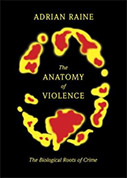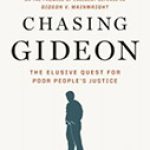The Anatomy of Violence: The Biological Roots of Crime
 Author: Adrian Raine
Author: Adrian Raine
Publishing: New York: Pantheon Books, 2013. 478p.
Reviewer: Jim Finckenauer | July 2013
This wide-ranging, multi-faceted, and in many ways unusual book is subtitled, The Biological Roots of Crime. The author, Adrian Raine, is a professor of criminology, psychiatry and psychology at the University of Pennsylvania. That description alone should alert one to the fact that Raine is a most unusual person, being one of only a small handful of scholars who bridge or have bridged these fields. But as readers of The Anatomy of Violence will quickly note, this is not the only manner in which Adrian Raine is unusual, and perhaps even unique.
Professor Raine has admittedly taken on a topic that has a long history of stirring controversy in criminological circles – and no less so today. For example, just out of curiosity, I pulled from my book shelves a well-known and widely used textbook in criminology – a text that has appeared in multiple editions and influenced throngs of criminology students over the years. The edition I happen to have of Principles of Criminology by Edwin Sutherland and Donald Cressey (two of the giants of criminology) is the sixth. Following what Sutherland and Cressey described as a survey of the facts regarding physical and physiological conditions and crime, they concluded as follows:
“The general conclusion…is that these [physical and physiological] conditions have not in any case been demonstrated to be a direct force in the production of crime or delinquency. On the contrary, it is apparent that these conditions are significant in crime causation only to the extent that they affect social interaction” (Sutherland & Cressey, 1960:115) (italics added).
Is their conclusion unusual or dated? Not at all! After all, criminology – the study of crime and criminal behavior – was born in sociology. Its roots lie in seeking the explanations for crime in societal and social environmental conditions. The determinism in the debate between free will versus determinism is a determinism shaped by poverty, socioeconomic status, racism and discrimination, community organization, social networks, differential learning, and so on. It is not determinism by individual biology.
One competing view to this idea of social determinism can be traced way back to a different breed of criminological giant — Cesare Lombroso. Lombroso and his followers Garofalo and Ferri – were members of the 19th century Italian School that promulgated a bio-typological explanation of criminal behavior. It is relevant to mention Lombroso in particular because he plays quite an important role in Raine’s Anatomy of Violence. Other biological and psychiatric theories have arisen over the years, but sociological criminology has maintained its dominance. For example, in perusing the program book for the 2011 conference of the American Society of Criminology, I noted a topic index category labeled Biosocial or Genetic Factors. There were 22 sessions of various kinds listed under this heading. This was 22 of over 800 sessions overall, or less than three percent; interestingly, Adrian Raine was a participant in four of these 22 sessions!
As is characteristic of many subject domains in the academic world, competing theories and views become the bases for intellectual warfare. Opposing theories must not only be refuted in the true spirit of science, but seemingly destroyed, and the theoreticians themselves ridiculed and even demonized. This sort of war of ideas has been waged in criminology with respect to the role of biology in crime. Dr. Raine not only highlights this ideological and scientific dispute, but uses it as a starting point for what he hopes will be a more reasoned and reasonable dialogue that will result in a middle ground, or at least a meeting of the minds.
To this end, Raine explicitly points out three objectives in the introduction to his book: “to inform readers of …intriguing new scientific research…focusing on the biological basis for crime and violence….to stress that social factors are critical both in interacting with biological forces in causing crime, and in directly producing the biological changes that predispose a person to violence….and to explore…the practical implications of …emerging neurocriminological knowledge” (p. 9).
At numerous points in his discussion, Dr. Raine gives hints (sometimes more than hints) of his frustration and exasperation bordering on anger with what he views as a dug-in resistance to what he and other neurocriminologists are doing and finding. For instance, he says that “to recognize that secular trends and both rises and falls in violence can be partly attributed to brain dysfunction—and not to better policing or to gun control or to the end of the crack epidemic—would be to recognize the explanatory power of biology theories. Currently that’s something very difficult for many social scientists to accept” (p. 227). There are points in the book where his frustration spills over in the direction of being a scold, and of becoming kind of haranguing and preachy.
Having read too many academic, scholarly tomes to count, and knowing all too well how dense and sometimes incomprehensible they can be — and on top of that not being a “real” scientist in the sense of being steeped in the natural sciences — I approached reading The Anatomy of Violence with somewhat mixed feelings. But to put it mildly, I was very pleasantly surprised. Raine writes in a very accessible style, and even though the terminology is occasionally complex, the extensive use of illustrations and case examples makes the discussion understandable to the non-scientists who are his primary audience. Readers are treated to a fascinating file of cases illustrating various forms of brain injury, congenital birth defect, brain disease, psychopathy, etc., that have led to violence. The cases include a host of murderers, serial killers, and sexual predators, and Dr. Raine clearly demonstrates in each case a correlation between brain malfunction and the violent behavior that ensued.
Another characteristic of this book – one to which I alluded earlier in mentioning that Raine is unusual and perhaps unique – is the author’s frequent use of personal examples and illustrations. This too makes the book especially accessible. He tells many personal experiences, and not all of them flattering. We learn his IQ, that he has several nurses in his family, that he made alcohol for consumption in his youth, that he was a bullying victim, that he was a hero on an airplane, and so on. He even includes a scan of his own brain among those of the serial killers he discusses. The impression one has is of a learned, but gentle and personable professor, describing and discussing and provoking undergraduate students to think outside of the box, as the cliché goes. The author is not at all shy about offering his personal reflections. You may not agree with everything he says, but you will take away some food for thought and have your preconceived notions and stereotypes challenged. And after all, this is what learning is or ought to be all about.
All of the above said, I take issue with Professor Raine’s book in several areas. First, I disagree with what I take to be his understanding of just deserts. Raine is very critical of just deserts, which he connotes with retribution and with the kind of rage that seeks revenge. He describes just deserts as a “valley of darkness” and a “barren desert.” In fact, however, just deserts is an effort to insure greater fairness in the punishment of criminals by linking the severity of the sanction they receive with the seriousness of the harm they have committed. It is an effort to insure that the punishment is commensurate with the harm done and the blameworthiness of the individual who has committed the harm. “Blameworthiness” indeed takes into account the sorts of factors Raine contends ought to be considered in holding offenders responsible and legally culpable. The idea of just deserts is to treat like cases alike and thus avoid unwarranted disparity in punishments. This is as opposed to punishing offenders for what they might do in the future – based upon some prediction of future conduct – a sentencing policy that leads often to punishing some people for who they are, rather than for what they have done.
It is exactly this kind of risk prediction that is the second area where I have concerns about some of Raine’s ideas in his concluding chapter entitled The Future: Where Will Neurocriminology Take Us? Completing the book, I asked myself the question, so what? In my mind, there is an obvious dilemma about what do, if anything, with much of the information Dr. Raine has provided.
In fairness, Raine is not advocating for everything he lays out here, and in fact appears to be playing a kind of devil’s advocate in some cases in order to stimulate critical thinking. Moving beyond the science-based discussion of the previous chapters, at the end Raine embarks on a kind of futuristic, almost science fiction excursion. One component of this future according to Adrian Raine, is a program called LOMBROSO (Legal Offensive on Murder: Brain Research Operation for the Screening of Offenders). Putting aside the clever acronym (perhaps overly cute), Raine envisions LOMBROSO being put into effect by the government in 2034. What would it do? In essence, subject all males eighteen and over to brain scans and DNA testing. Those who test LP (Lombroso Positive) would be put into indefinite detention. The detention centers that would house those predicted to be at high risk of violence Raine describes as “highly secure, but not the harsh holding bays of decades gone by.” Instead, he says, “they are equipped as a home away from home.” They have conjugal visits, recreational and educational services, inmates allowed to vote, etc. The so-called LPs can challenge their initial classification, and are to be reassessed every year. They may be returned to the community under supervision, or eventually age out of the LP designation, or in the case of predicted sexual predators, undergo surgical castration. Dr. Raine says this treatment may sound cushy. It does not to me! The only problem? How about the fact that none of these individuals being locked up have actually committed a crime? They are incarcerated for who they are, not what they have done. Here Raine is correct in the sense that this is certainly a long way from just deserts.
Under the Raine futuristic scenario, to accompany LOMBROSO, which is “working well,” the government announces a National Child Screening Program (NCSP) in 2040. Under this junior version, ten-year old rotten apples (children predicted to have a 48 percent chance of becoming a serious violent offender) are to be taken away from their families to be placed in residential treatment for two years of intensive biosocial therapy. As further parts of this invention of a certain kind of future, are such ideas as requiring fathers of “red zone” children (high risk) to be detained retroactively under the LOMBROSO program, having a requirement to get a license to have a baby, and having compulsory parenting classes in schools leading to required licensing exams. Again, Dr. Raine is not necessarily advocating for all these policies, but is instead attempting to challenge the status quo and to provoke thinking and discussion. The latter certainly worked for me!
That the author is, however, very sympathetic to interventions of these kinds, if not necessarily to all their specifics, comes across quite loud and clear. He argues, for example, that we should be “identifying children with serious behavior problems for benign interventions.” When I read this, I am reminded from too much of our unfortunate history in dealing with offenders – and in particular juvenile offenders – of the admonition that the road to hell is paved with good (read benign) intentions!
Whether you shake your head in agreement or in disbelief, The Anatomy of Violence will very definitely provoke your critical thinking, and further will create some healthy cognitive dissonance among skeptical traditional criminologists. For these reasons, I highly recommend it.
Jim Finckenauer, PhD,
Professor Emeritus & Professorial Fellow,
Rutgers University


